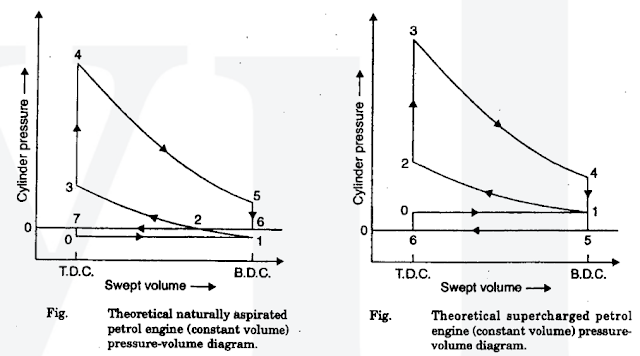
Naturally Aspirated (NA) Cycle of Operation
Process:
Intake Stroke: Air-fuel mixture enters at atmospheric pressure (~1 bar).
Compression Stroke: Mixture is compressed (CR: 8:1 to 12:1).
Power Stroke: Spark plug ignites mixture, expanding gases.
Exhaust Stroke: Burnt gases exit at near-atmospheric pressure.
PV Diagram:
Shows a narrow loop with lower peak pressure (limited by ambient air density).
Work output per cycle = Area enclosed by the cycle.
2. Actual NA vs. Supercharged Engine Comparison
| Parameter | Naturally Aspirated | Supercharged |
|---|---|---|
| Intake Pressure | ~1 bar (atm) | 1.5–2.5 bar (boosted) |
| Air Density | Lower | Higher (more O₂ molecules) |
| Volumetric Efficiency | 70–90% | 100–150% (forced induction) |
| Power Output | Limited by displacement | +30–50% (or more) |
| Thermal Efficiency | Higher (no parasitic loss) | Slightly lower (energy to drive SC) |

Thermodynamic Cycle & Supercharging Power Otto Cycle Modifications:
Increased 𝑃₃ (peak pressure): More air/fuel → Higher expansion work.
Higher 𝑇₃ (combustion temp): Requires premium fuel (higher octane).
Power Gain Equation:
Example: 1.5 bar boost → ~50% more power.
Parasitic Loss: Supercharger consumes 5–15% of engine power.

Key Points on Supercharging S.I. Engines
Knocking Risk:
Higher pressure/temperature can cause pre-ignition (requires high-octane fuel).
Heat Management:
Intercoolers must reduce intake air temp (↓ detonation risk).
Fuel Enrichment:
Extra fuel is often injected to cool combustion chambers.
Compression Ratio (CR):
Supercharged engines typically run lower CR (e.g., 8:1 vs. 11:1 NA).
Emissions:
Higher NOx due to increased combustion temps (may need EGR).
Supercharging Limits in S.I. Engines
Knocking Threshold:
Practical boost limit: ~1.5–2.0 bar (varies with fuel octane and cooling).
Material Strength:
Pistons/rods must handle higher peak pressures.
Thermal Stress:
Exhaust valves and turbo components face extreme heat.
Fuel Quality:
Low-octane fuel severely limits boost potential.
Summary Table: Supercharging vs. NA S.I. Engines
| Aspect | Naturally Aspirated | Supercharged |
|---|---|---|
| Peak Power | Limited by displacement | +30–50% typical |
| Throttle Response | Good | Instant (vs. turbo lag) |
| Efficiency | Higher (no parasitic loss) | Lower (SC consumes power) |
| Knocking Risk | Low | High (requires mitigation) |
| Cost | Lower | Higher (hardware + tuning) |
Final Notes
Supercharging trades efficiency for power density.
Best for applications where low-end torque and throttle response are critical (e.g., drag racing, muscle cars).
Modern solutions combine supercharging + turbocharging (e.g., Volvo’s Twin-Charged engines).

Post a Comment